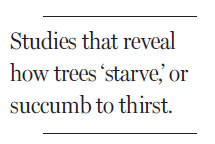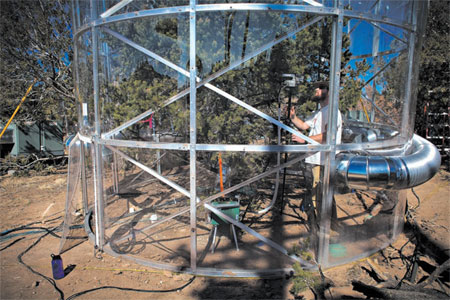Clues to why forests die
Updated: 2013-01-06 11:58
By Sandra Blakeslee(
The New York Times
)
|
|||||||
|
An experiment in New Mexico monitors how trees respond to higher temperatures and less water. Mark Holm for The New York Times |

LOS ALAMOS, New Mexico - Everywhere, trees are dying. The boreal forests of Canada and Russia are being devoured by beetles. Drought-tolerant pines are disappearing in Greece. In North Africa, Atlas cedars are shriveling. Wet and dry tropical forests in Asia are collapsing. Australian eucalyptus forests are burning. The Amazon basin has just been hit by two severe droughts. And it's predicted that trees in the American Southwest may be gone by the end of this century.
But scientists do not fully understand how trees die. Certainly warmer temperatures, lack of water and insects play a role. But why do some trees die while others survive?
Nate McDowell, a staff scientist at the Los Alamos National Laboratory in New Mexico, aims to find answers. Dr. McDowell, a plant physiologist, has set up an experiment for trees. By speeding up aspects of climate change - more heat, less water - he hopes to document their death.
The two competing theories explaining tree death are that they die of thirst or they starve to death.
In Dr. McDowell's experiment, 63 pinyon and juniper trees are being monitored for how they breathe, make food, take up or release water, fight off insects and cope with air that is warmer than usual. Of those, 32 are enveloped in Plexiglas and steel chambers, tops open to the sky, and hooked up to devices that measure every aspect of their metabolism.
The experiment is near Bandelier National Monument near Los Alamos, whose residents abandoned their cliff dwellings during a megadrought in the 13th century. The region endured a second major drought in the 16th century.
In those droughts, Dr. McDowell said, forests died but conditions rebounded. This time, he said, the rise in temperature is not expected to rebound because it is caused by human activity. It is happening faster than at any time in the geologic record. What's new, scientists say, is that this warmer air acts like a sponge. Even if rain and snow levels remain the same, the atmosphere will pull that moisture away from the soil and trees.
To monitor how trees might succumb to thirst, researchers are measuring water flow inside each trunk. Normally ropes of water molecules are pulled up from the soil and roots by the atmosphere, moving through very small channels called xylem. When the air is warm, it exerts a greater pull on the water, increasing tension. If the tension gets high, the rope breaks and air is introduced. Like an embolism that can kill a person, air bubbles can block the flow of water and a tree can dry out and die. A study found that 70 percent of 226 forest species from 81 sites worldwide now live on the edge of this so-called hydraulic failure.
To observe how trees might starve to death, researchers are also measuring how much carbohydrate, or food, each tree makes from the carbon dioxide taken up by its needles during photosynthesis. In a drought, many trees defend themselves by closing the pores, or stomata, in their leaves or needles to prevent water loss. This shuts down photosynthesis, forcing the tree to consume its carbohydrate stores. When it runs out, it can starve to death.
The experiment began in June. So far the bulk of evidence is consistent with the idea that the trees are drying out or starving, Dr. McDowell said.
"Only by understanding the cascade of steps that lead to tree mortality can we make accurate predictions into the future," he said.
The New York Times
(China Daily 01/06/2013 page11)
